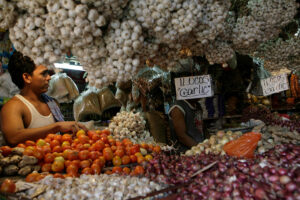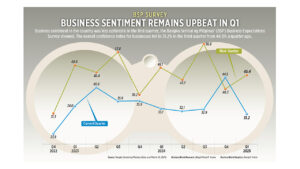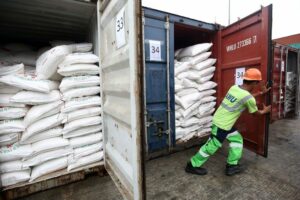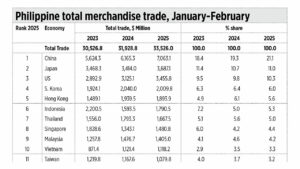DA may impose MSRP for imported garlic

By Justine Irish D. Tabile, Reporter
THE Department of Agriculture (DA) said on Monday that it is looking at imposing a maximum suggested retail price (MSRP) for imported garlic as market prices remain stubbornly high.
“Of course, what we want is to fix this through talks, so we do not have to put an MSRP (on garlic). But if they do not want to follow, we might put an MSRP (on garlic),” Agriculture Secretary Francisco P. Tiu Laurel, Jr. told reporters after inspecting a public market in Quezon City.
The results of the market monitoring on Monday showed that prices of agricultural products such as rice, pork, and fish are going down, but prices of garlic remain elevated.
“The only thing that we are not happy with is the price of garlic. It is a bit expensive as it is being sold at P140-P150 a kilo,” Mr. Laurel said.
“The DA is trying to figure out how to address that and lower its price because it is imported. Ninety-five percent of the garlic in our markets is imported, so we will have to control that,” he added.
According to the Agriculture secretary, importers are selling garlic at P110 per kilo, even though the landed cost is at P80 per kilo.
“The vendor said they bought (garlic) for P110 per kilo. So, if they sell it at P140, they will have a P30 profit. We will check if that P30 per kilo is expensive or not, but I think it is fair,” he said.
“But the garlic importers, their cost is only P80 a kilo, but they sell it for P110 a kilo. And that is if they are declaring the right values, but I know that they sometimes undervalue, so maybe their margin is P40-P50 per kilo. I think that is too much,” he added.
Mr. Laurel said that the DA is just compiling the final figures before calling for a meeting with importers. However, he said he thinks garlic should only be sold at P100-P110 per kilo.
Sought for comment, Samahang Industriya ng Agrikultura (SINAG) Executive Director Jayson H. Cainglet said that only 5% of garlic is locally produced, which is why the group welcomes the proposal to impose MSRP on imported garlic.
“The landed cost of garlic is between P70 and P80 per kilo only, so the retail price should not exceed P130-140 per kilo,” he said in a Viber message.
“If its price exceeds P150 per kilo, it is clear that there is profiteering along the value chain of imported garlic,” he added.
However, Mr. Cainglet said the government has very limited options for short-term interventions, as most garlic is imported.
“One long-term intervention could be the revival of the local garlic industry so that we will have more control over the entire supply chain,” he said.
Federation of Free Farmers National Director Raul Q. Montemayor said there is rampant profiteering in garlic imports, same as with rice, pork, and other commodities.
“Garlic is being brought into the country at a declared landed price of only P25 per kilo. Its real landed price is about P60 per kilo, and importers declare a lower price so that they end up paying lower tariffs,” he said in a Viber message.
“Even then, the retail price of garlic currently is about P140 per kilo, and sometimes reaches P200 per kilo, indicating huge profit margins. The MSRP may help, but we may have to look for additional ways to control profiteering,” he added.
Mr. Montemayor said the government could use the Price Act or the Anti-Economic Sabotage Law to run after profiteers.
“The longer-term goal is to help our local farmers improve their productivity and output so that they can supply more garlic at a competitive price,” he added.
On the other hand, Philippine Chamber of Agriculture and Food, Inc. (PCAFI) President Danilo V. Fausto said that there is no “unreasonable movement of prices of garlic which requires government intervention.”
“Garlic and onions are of similar nature in the manner of production and price movement. One thing that is important is that we need to encourage more farmers to plant garlic to increase supply,” he said in a Viber message.
For his part, Mr. Laurel said garlic needs temperate weather, which makes it difficult to cultivate garlic in the country.
“Secondly, our planting material, our traditional garlic variety, is small but has a different taste. No one can beat China in the production of garlic in the whole world, so even Thailand, Vietnam, Cambodia, Indonesia, and Taiwan buy from them,” he said.
Mr. Laurel said the DA is also looking at using Korean technology that would boost production to 12-15 tons of garlic per hectare. In the Philippines, farmers produce only about one to two tons of garlic per hectare.
Aside from garlic, Mr. Laurel said that the DA is also monitoring the price of chicken and eggs to see if there is a need to impose a price cap.
The DA is also looking at maintaining the P45 MSRP on rice to ensure that the farmers will have a profit.
“Actually, our initial idea is to lower it further to P42, but with what is happening with our price in the harvest season, it is going down,” he said. “So now, I think it is prudent that we will stop at MSRP P45 for the next two months until the harvest season ends.”




